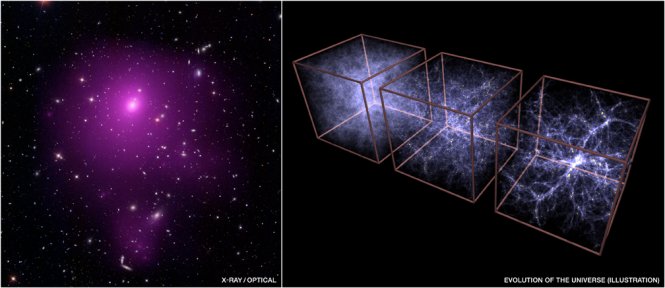Other massive stars have raced through their evolution and exploded catastrophically as supernovae, expanding these bubbles into X-ray- brightened superbubbles. They leave behind pulsars as beacons of their former lives and expanding supernova remnants that trigger the collapse of giant clouds of dust and gas to form new generations of stars.
At the center of 30 Doradus lies the star cluster R136 at the intersection of three of these superbubbles. However, with ages only between one and two million years old, the stars in R136 are too young to be source of the supernovae that brighten the superbubbles in X- rays. Instead, R136 is most likely just the latest cluster to form in 30 Doradus. It may be as massive as it is because these superbubbles have combined to concentrate their gas in this region and thus triggered intense star formation there.

Credit: X-ray (NASA/CXC/SAO/A.Vikhlinin et al.); Optical (SDSS); Illustration (MPE/V.Springel)
The composite image on the left is of the galaxy cluster Abell 85, located about 740 million light years from Earth. The purple emission is multi-million degree gas detected in X-rays by NASA's Chandra X-ray Observatory and the other colors show galaxies in an optical image from the Sloan Digital Sky Survey. This galaxy cluster is one of 86 observed by Chandra to trace how dark energy has stifled the growth of these massive structures over the last 7 billion years. Galaxy clusters are the largest collapsed objects in the Universe and are ideal for studying the properties of dark energy, the mysterious form of repulsive gravity that is driving the accelerated expansion of the Universe.
The illustration on the right shows snapshots from a simulation by Volker Springel, representing the growth of cosmic structure when the Universe was 0.9 billion, 3.2 billion and 13.7 billion years old (now). This shows how the Universe has evolved from a smooth state to one containing a vast amount of structure. Gas is shown in these snapshots, where the yellow regions are stars and the brightest structures are galaxies and galaxy clusters. The growth of these structures was initially driven only by the attractive force of gravity, but then later there was competition with the repulsive force of dark energy.
Understanding the nature of dark energy is one of the biggest problems in science. Possibilities include the cosmological constant, equivalent to the energy of empty space, a modification in general relativity on the largest scales, or a more general physical field. To help decide between these options, Chandra was used to study the increase in mass of galaxy clusters with time over the last 7 billion years. The results are remarkably consistent with those from previous results that measure the expansion of the Universe using distance measurements, revealing that general relativity works as expected on large scales. The cluster work, in combination with other studies, also provides the strongest evidence to date that dark energy is the cosmological constant, or that `nothing weighs something'.
30 Doradus is about 160,000 light years from Earth in the southern constellation of Dorado. It spans 800 light years across and is incredibly bright in many wavelengths. If it were at the distance of the Orion Nebula (1,300 light years), 30 Doradus would span the area of 60 full Moons and its optical light would be bright enough to cast shadows at night on the Earth. This latest X-ray image of 30 Doradus represents almost 114,000 seconds, or 31 hours, of observing Chandra time – three times longer than previously recorded. In this image, red represents the lower range of X-rays that Chandra detects, the medium range is green, while the highest-energy X-rays are blue.





Comments